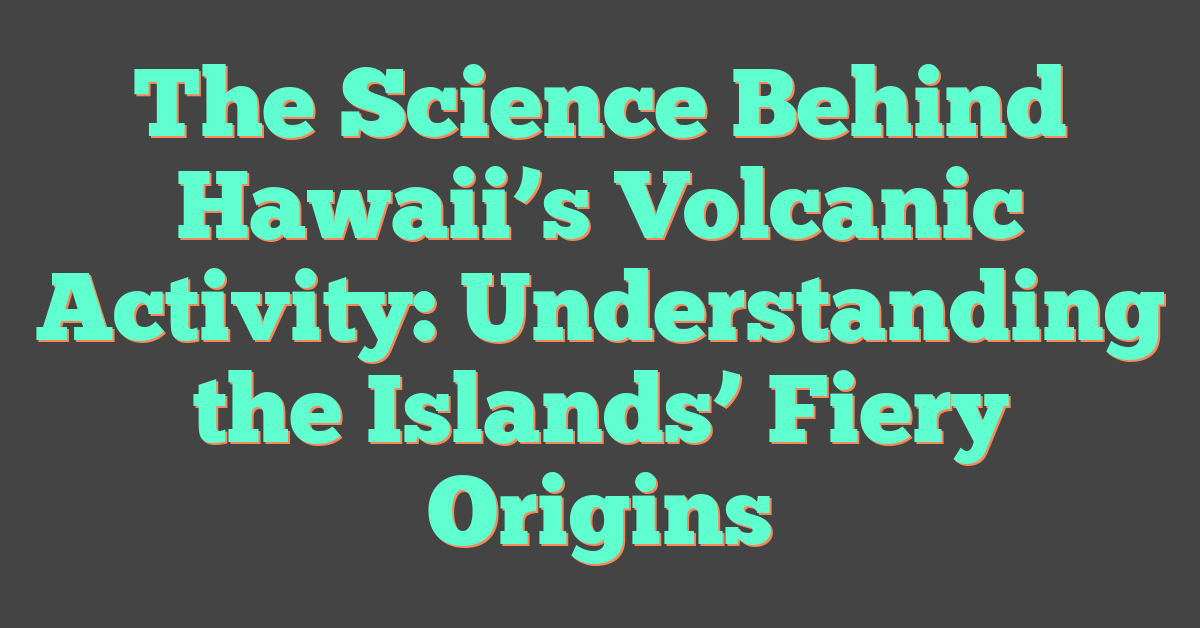Hawaii is famous for its beautiful beaches and lush landscapes. Its volcanoes, however, are what truly shape the islands.

Each year, visitors and locals watch in awe as volcanoes create dramatic lava flows and new land. These eruptions make Hawaii unique.

Hot molten rock, or magma, pushes its way through cracks deep underground. This process causes eruptions that reshape the land quickly.
Hawaii’s shield volcanoes, like Mauna Loa and Kilauea, rank among the largest on Earth. They tower above the sea and also stretch thousands of feet below the ocean floor.
These huge mountains are hidden beneath the islands’ surface. The Hawaiian Volcano Observatory offers more details about what happens underground.
Learning about these powerful events helps people stay safe. It also encourages appreciation for Hawaii’s ever-changing landscape.
Overview of Hawaii’s Volcanic Activity
Frequent eruptions and slow magma movement shape Hawaii’s volcanic landscapes. On the Big Island, volcanic activity creates new land and changes local communities.
The Big Island is a unique place to study how volcanoes shape our world.
Defining Volcanic Activity
Volcanic activity happens when molten rock, or magma, moves from deep inside the Earth to the surface. This can appear as lava flows, or as bursts of ash, steam, and gases.
The process begins far below the islands at a hot spot in the Earth’s mantle. In Hawaii, this activity is easy to spot.
Black fields of cooled lava, small earthquakes, and the smell of sulfur all signal volcanic activity. Scientists watch for changes by studying earthquakes, ground swelling, and gas release.
Hawaiian eruptions usually start with slow-moving lava, not explosions. Sometimes the lava travels for miles, covering roads and homes.
The Hawaiian Volcano Observatory monitors activity and warns people when eruptions may happen. You can find more information at the USGS Hawaiian Volcano Observatory page.
Major Volcanoes of Hawaii
Mauna Loa and Kīlauea on the Big Island are the most active volcanoes in Hawaii. Mauna Loa is the world’s largest volcano by volume, rising 13,678 feet above sea level.
Its gentle slopes come from thousands of years of lava flows. Kīlauea has erupted almost nonstop since 1983, making it highly studied.
Frequent eruptions build broad, shield-shaped mountains. Mauna Kea, though less active, is the highest point in Hawaii.
Haleakalā on Maui is dormant but still attracts scientists and visitors. Each volcano has its own history and eruption style.
For more details, visit National Geographic’s Hawaii volcano guide.
Volcanic Eruptions and Their Impact
Eruptions on the Big Island add new layers of rock and reshape the land. When lava reaches the ocean, it creates steam plumes and new land.
Sometimes, lava flows force entire neighborhoods to evacuate. Fresh lava can cover forests and farmland.
Volcanic gases like sulfur dioxide create “vog,” a haze that can make breathing difficult for some people. Local communities respond with alerts when danger rises.
The activity brings visitors and scientists who want to study volcanoes up close. Real-time updates are available at the USGS Kīlauea Volcano Updates.
Geological Foundations: The Hawaii Hotspot
The Hawaii hotspot is why Hawaii has so many volcanoes. It links deep Earth forces to the chain of islands that make up Hawaii.
How Hotspots Form
Hotspots form away from plate edges, unlike most volcanoes. They appear where hot rock rises from deep inside the Earth, in the mantle.
A plume of heat forms under the crust. As the plume rises, the pressure drops and the rock melts, turning into magma.
Magma pushes through weak spots in the crust and erupts at the surface. The Hawaiian hotspot sits under the Big Island.
Eruptions build islands as lava cools and hardens. You can read more about this at NOAA Ocean Exploration’s explanation of the Hawaiian hotspot.
Pacific Plate Movement
The Pacific Plate, one of the largest tectonic plates, moves slowly over the Hawaii hotspot. As the plate slides northwest, old volcanoes become extinct and new ones form above the hotspot.
This movement creates the chain of Hawaiian islands across the Pacific Ocean. Volcanoes get older as you travel northwest along the chain.
Plate movement also causes earthquakes and changes the islands’ shape. For more details, visit National Geographic’s page about the Hawaiian hot spot and plate movement.
Creation of the Hawaiian Islands
The Hawaiian Islands formed from hotspot volcanic activity. Lava from eruptions built up on the ocean floor and broke the surface to make islands.
The youngest island, Hawaii, keeps growing as new lava flows from its volcanoes. The Pacific Plate carries each island away from the hotspot after it forms.
Over millions of years, this process has created a chain of islands and underwater mountains. The chain keeps growing as long as the hotspot stays active. More information is at Geology.com’s discussion on Hawaiian Islands and the hotspot.
The Structure and Life Cycle of Hawaiian Volcanoes
Hawaiian volcanoes have a unique shape and way of growing. They form slowly, starting deep under the ocean and rising above sea level.
Different stages shape how they look and behave.
Shield Volcano Formation
Hawaiian volcanoes like Mauna Loa and Kīlauea are called shield volcanoes because of their broad, gentle slopes. Their shape looks like a warrior’s shield.
Lava flows out quietly and travels far before cooling, creating wide layers. Most of the lava is basalt, a runny type that spreads smoothly.
Eruptions begin underwater, building up the island base. Over thousands of years, eruptions lift the volcano above the ocean’s surface.
Mauna Kea and Mauna Loa are clear examples of this shield-like formation. Even though their eruptions are not usually explosive, they produce a lot of lava.
This slow build-up forms the large Hawaiian Islands seen today. For more on volcano formation, visit the U.S. Geological Survey’s explanation of the evolution of Hawaiian volcanoes.
Key Stages of Volcanic Growth
Every Hawaiian volcano goes through growth and decline stages. The first stage is submarine, when the volcano is underwater.
As eruptions continue, the volcano enters an explosive phase and reaches above sea level. Next comes the shield-building stage, with broad, gentle slopes.
Mauna Loa and Kīlauea are in this phase now, with frequent eruptions adding new lava. As eruptions slow down, the volcano enters the post-shield stage.
Thicker lava cools quickly, forming a cap on older rock. Over time, the volcano becomes dormant, and erosion wears it down.
Some volcanoes may stop erupting earlier or skip certain stages. The USGS overview of Hawaiian volcano evolution explains this in more detail.
Magma Dynamics and Lava Flows
Hawaii’s active volcanoes rely on deep magma movement and special types of lava. Understanding where magma comes from and how it moves helps explain the frequent lava flows.
Sources and Pathways of Magma
Magma under Hawaii starts far below the island, in the Earth’s upper mantle. It rises through cracks and channels and collects in magma chambers.
Kīlauea and Mauna Loa, the island’s most active volcanoes, draw from a shared magma source. When one volcano erupts often, the other can become quieter because they share the same supply.
After magma fills a volcano’s chamber, it can move upward quickly during eruptions. The magma travels through tunnels and tubes, then reaches the surface as lava.
The chemical makeup of the magma can change as it moves, affecting the color and behavior of the lava. Underground features influence the direction and speed of magma flow, which scientists study using earthquake patterns.
Types of Lava in Hawaii
Hawaii has two main types of lava: pāhoehoe and ʻā‘ā.
Pāhoehoe is smooth and flows like thick honey. When it cools, it forms shiny, rope-like shapes.
ʻĀ‘ā is rough, chunky, and moves slower. As it cools, it breaks into sharp, jagged rocks.
Basaltic magma, rich in iron and magnesium but low in silica, creates both types of lava. This magma is very fluid and lets lava travel far from the eruption site.
Some eruptions send out large lava flows that can cover big areas quickly.
Minerals and gases in the magma affect the type of lava that forms. Temperature, gas content, and flow rate also make a difference.
Understanding Volcanic Eruptions
When volcanoes erupt in Hawaii, hot lava, ash, and gases rush out from openings in the ground. These eruptions can be sudden, but warning signs often appear first.
Volcanic gases released during eruptions can affect the eruption itself and the health of nearby people.
Triggers and Warning Signs
A volcanic eruption starts when magma collects in a chamber underground. As more magma moves in, pressure builds.
Earthquakes often happen before an eruption because the magma pushes against rock and cracks it open. Scientists use these small earthquakes to predict volcanic activity.
Swelling or bulging of the ground is another warning sign that magma is moving upward. In Hawaii, scientists track these changes with special sensors.
Temperature near volcano vents rises before an eruption. Scientists also watch gas levels and tiny shifts in the soil to predict what might happen.
Kilauea and Mauna Loa are Hawaii’s most active volcanoes. They often show these warning signs in advance.
Learn more about eruption triggers at Understanding the science behind Kilauea’s eruptions.
Volcanic Gases and Their Effects
During eruptions, volcanoes release gases like water vapor, carbon dioxide, and sulfur dioxide. Sulfur dioxide is especially important because it can create vog, a volcanic smog.
Vog makes breathing difficult, especially for children or people with asthma. The gases can also mix with water to form acid rain, which can harm plants, buildings, and skin.
Scientists measure gas levels before, during, and after eruptions. This information helps researchers understand why eruptions happen.
To read more about volcanic gases and their impact, visit The Science Behind Volcanoes and Their Eruptions.
Monitoring Hawaii’s Volcanoes
People in Hawaii use expert organizations and advanced technology to watch volcanoes closely. Careful monitoring keeps communities safe and gives scientists valuable data during eruptions and earthquakes.
Role of the U.S. Geological Survey
The U.S. Geological Survey (USGS) leads volcano research in Hawaii. At the Hawaiian Volcano Observatory (HVO), geophysicists and volcanologists track activity at volcanoes like Kīlauea and Mauna Loa.
HVO teams use fieldwork and data analysis to study lava flows, gas releases, and ground movements. Their regular updates help people living near active volcanoes stay informed.
Their research guides local safety planning during eruptions. HVO also monitors small earthquakes, since these can signal magma movement underground.
USGS facts:
- Over 100 years of volcano monitoring in Hawaii
- Develops new tools for real-time observation
- Shares data with emergency officials
Techniques: GPS and Seismic Monitoring
GPS and seismic monitoring are key ways to track volcanic activity. GPS stations on volcano slopes detect tiny shifts in the ground.
When magma moves, it pushes the land up or out, and GPS sensors notice these changes quickly.
Seismic monitoring uses sensitive seismometers to record earthquake activity linked to magma movement. Most of these quakes are too small to feel, but they help volcanologists see where magma is traveling.
Here’s a quick comparison table:
| Technique | What it Measures | Importance |
|---|---|---|
| GPS | Land movement (uplift, spreading) | Shows magma movement and pressure buildup |
| Seismic | Earthquake frequency and size | Detects magma movement and eruption risk |
Combining GPS and seismic data gives a clearer picture of underground activity. This helps scientists issue warnings in time and protect lives and property.
For more details, visit the USGS Hawaiian Volcano Observatory.
Cultural and Environmental Influence

Hawaii’s volcanoes shape the islands’ land, traditions, art, and even the beaches. They are more than just molten rock and ash.
Pele: The Goddess of Fire
Hawaiians know Pele as the powerful goddess of fire and volcanoes. She is seen as both creative and destructive.
Many legends say she lives in the Halemaʻumaʻu crater at Kīlauea, making the volcano deeply respected. People often leave offerings for Pele, such as flowers or fruit, to gain her favor.
Her presence is felt strongly during eruptions, which are sometimes seen as signs of Pele’s moods or travels.
Children in Hawaii grow up hearing stories about Pele. These legends help them understand the volcanic forces shaping their home.
Volcanoes in Hawaiian Culture
For Hawaiians, volcanoes stand for life, death, and renewal. Artists use the volcanic landscapes as inspiration for paintings, dances, and music.
Hula, the traditional dance, often tells stories of eruptions and Pele’s adventures. Villages sometimes face real danger during eruptions.
The 1960 Kīlauea eruption destroyed the village of Kapoho. Even when eruptions threaten homes, Hawaiians see these events as part of the islands’ cycles.
People pass down volcano knowledge through stories, songs, and Hawaiian language newspapers. They use both old beliefs and science to understand the land.
Formation of Black Sand Beaches
Black sand beaches form when lava flows into the ocean, cools quickly, and shatters into tiny black grains. Over time, waves gather these grains to create black sand beaches.
These beaches provide unique homes for plants and animals. Lava soil is full of minerals, supporting rare greenery found only in Hawaii.
In places like Hawai‘i Volcanoes National Park, new lava flats and beaches appear within months after an eruption. Their striking color and rugged beauty show that volcanic activity brings both change and new beginnings.
Many locals see black sand beaches as having cultural importance. They connect them to the story of Pele and the growth of the islands.
Notable Hawaiian Volcanoes
Hawaii’s landscape features volcanoes that are still active or have shaped the islands’ history. Each volcano has its own size, activity, and special features.
Mauna Loa
Mauna Loa is one of the world’s largest volcanoes. It rises about 13,678 feet above sea level and stretches across much of Hawaii Island.
Mauna Loa has a shield shape with broad, gently sloping sides. It is famously active, with more than 30 eruptions since the 1800s.
The most recent major eruption was in 2022 and lasted about two weeks. Mauna Loa’s lava moves quickly because it is very fluid.
Local communities keep a close watch on it since its eruptions can reach populated areas.
Mauna Kea
Mauna Kea is the tallest mountain in Hawaii if measured from its base on the ocean floor, reaching about 33,500 feet total. Its summit is about 13,796 feet above sea level, higher than Mount Everest when measured from base to peak.
This volcano is dormant and hasn’t erupted in thousands of years. The summit is often cold and can even have snow.
Mauna Kea is famous for its observatories. The clear skies make it a great place for studying stars and planets.
For native Hawaiians, Mauna Kea is a sacred place. Access to some areas is limited to show respect for these traditions.
Kīlauea
Kīlauea is one of the most active volcanoes on Earth. It erupted almost nonstop from 1983 to 2018, adding over 400 acres to Hawaii’s coastline (learn more).
The eruptions at Kīlauea attract scientists and tourists from around the world. Its lava flows are usually slow-moving, so people can often watch them safely from a distance.
Sometimes, earthquakes or new fissures threaten homes and roads. Kīlauea is a central part of Hawaii Volcanoes National Park, which protects the land and lets people see volcanoes up close.
Volcanic Activity Across The Hawaiian Islands
The Hawaiian Islands formed from volcanic activity, but not every island is the same age or shows the same activity. Some volcanoes are still active, while others have been quiet for millions of years.
Big Island of Hawaii
On the Big Island, I find the most active volcanic region in Hawaii. Five main volcanoes make up this island: Mauna Loa, Mauna Kea, Kīlauea, Hualālai, and Kohala.
Mauna Loa, Kīlauea, and Hualālai have erupted in recent centuries. These eruptions shape the land and affect the people living here.
Kīlauea is famous for its frequent and dramatic eruptions. It ranks as one of the most active volcanoes in the world.
Mauna Loa is another giant that has erupted many times, even in recent decades. These volcanoes create new land when lava flows into the sea.
The Big Island is the youngest of the main Hawaiian Islands. Because of this, I see lush green rainforests next to fresh black lava fields.
This mix makes the island unique compared to the others. For more about recent eruptions and the timeline of volcanic events, I look to the USGS’s detailed chronology.
Kauai: The Oldest Island
Kauai is the oldest of the main Hawaiian Islands.
Its volcanoes stopped erupting millions of years ago.
I notice much more erosion here compared to the Big Island.
Wind, rain, and waves carved deep valleys and steep seaside cliffs.
Unlike the Big Island, Kauai does not have any active volcanoes.
Thick forests now cover the volcanic mountains.
Waterfalls dot the landscape.
Kauai’s age means erosion shapes its land more than fresh lava does.
Kauai’s long history created iconic features such as the Waimea Canyon and the Nā Pali Coast.
These dramatic landscapes show how time and nature changed the island.




